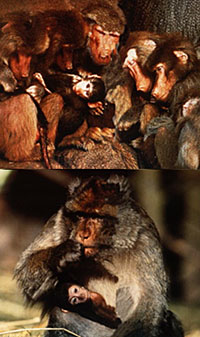 Neoteny is the retention into adulthood of juvenile characteristics.
Neoteny is the retention into adulthood of juvenile characteristics.The Physical Characteristics of Humans
- Page 21 -
Neoteny
 Neoteny is the retention into adulthood of juvenile characteristics.
Neoteny is the retention into adulthood of juvenile characteristics.
In mammals, the young of distantly related species often resemble one another, as in the case of the new-born Hamadryas baboon, left, and the young Barbary ape from Gibraltar, below left. The young of many mammals tend to have round, unspecialized faces and then, as they mature, they grow into whatever specialized features their species possess. Collie pups, for example, soon grow out of their cute, round, "generic pup" looks and acquire the distinctive, wolf-like muzzle of the adult collie.
To say that human beings as a species are characterized by neoteny is to note that, physically, we do not specialize very much as we mature. We retain, for the most part, the round faces and unspecialized features of our juvenile phase. In other words, our species is remarkably un-committed, biologically, to any specialized life-style. We remain, in terms of our anatomy, "generalists" even into adulthood.
In other words, neoteny is related to (perhaps makes possible) the remarkable adaptability of human beings, who remain even as adults able to adapt themselves to a wide array of life situations, rather than fitting perfectly into a single niche. Because of this characteristic, this behavioral plasticity, humans have fitted themselves to almost all the planet's environments, from the equator to near the poles, and from sea level to elevations higher than 12,000 feet.